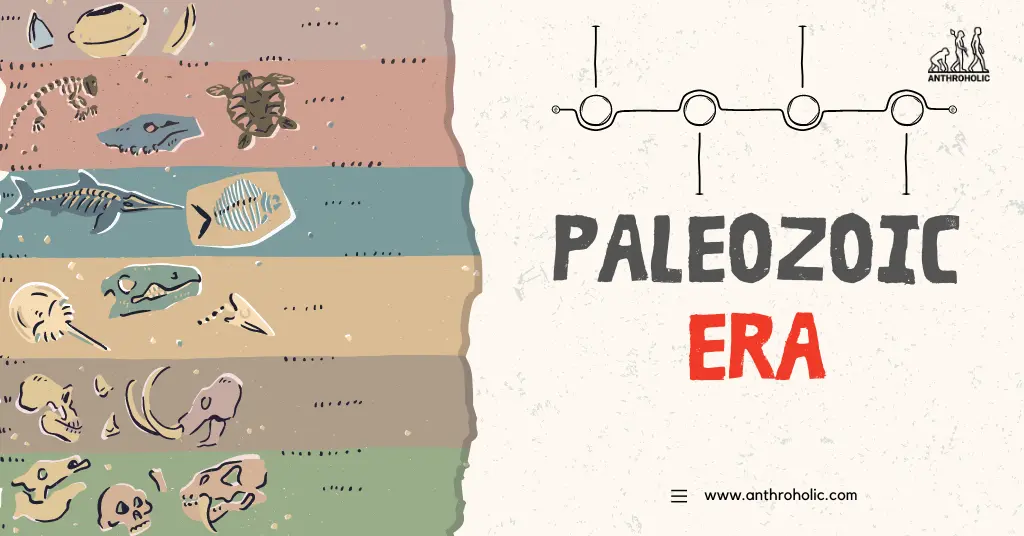AI Answer Evaluation Platform Live Now. Try Free Answer Evaluation Now
Paleozoic Era
The Paleozoic Era, meaning “ancient life,” spans a significant portion of Earth’s geologic timescale, from around 541 million to about 252 million years ago [1]. This prehistoric era is especially important as it signifies the proliferation of complex, multi-cellular life.

Periods of the Paleozoic Era
The Paleozoic Era is further divided into six distinct periods:
| Period | Years Ago (Million Years) |
|---|---|
| Cambrian | 541-485 |
| Ordovician | 485-443 |
| Silurian | 443-419 |
| Devonian | 419-359 |
| Carboniferous | 359-299 |
| Permian | 299-252 |
Each period is characterized by distinct climatic conditions and lifeforms, revealing a complex chronology of biological evolution and geological transformations [2].
- Cambrian Period: The “Cambrian Explosion” refers to the rapid diversification of multicellular life forms, which occurred during this period. Major groups of animals, such as the arthropods (which include insects and crustaceans), first appeared during this period [3].
- Ordovician Period: This period witnessed the colonization of the land by primitive plants and the first-known mass extinction at its end, triggered by glaciation and falling sea levels [4].
- Silurian Period: In this period, the first vascular plants appeared, and arthropods began to colonize the land. The world’s oceans continued to be a hub of invertebrate diversity [5].
- Devonian Period: Often termed the “Age of Fishes”, the Devonian Period experienced the first appearance of ray-finned and lobe-finned fish. It also saw the advent of the first trees and forests [6].
- Carboniferous Period: This period is known for its high oxygen levels and the diversification of insects. It was characterized by vast swampy forests that later formed coal deposits, hence the name Carboniferous [7].
- Permian Period: The Permian period ended with the largest mass extinction in Earth’s history, where nearly 96% of marine species and 70% of terrestrial life died out. This event marked the end of the Paleozoic Era [8].
Paleozoic Climate and Continental Movement
The Paleozoic Era was a time of dramatic geological and climatic changes. It began with the continents clustered around the South Pole and ended with them amalgamated into the supercontinent of Pangea [9].
Throughout the era, Earth’s climate transitioned several times between hot and cold phases, influencing the evolution and extinction patterns of various species. It moved from a greenhouse world in the Cambrian and early Ordovician to an icehouse world in the late Ordovician and Carboniferous periods, followed by a return to warmer climates in the Permian [10].
Fauna and Flora of the Paleozoic Era
The Paleozoic Era was a time of tremendous diversification and development of life forms.
Marine Life
The era commenced with the emergence of the earliest known hard-shelled animals. The Cambrian explosion led to the diversification of major groups of marine invertebrates such as trilobites and mollusks. The Ordovician period saw the emergence of the first coral reefs and primitive fish. By the Devonian period, the “Age of Fishes,” the ocean was full of a diverse range of fish, including the first sharks [11].
Terrestrial Life
The transition of life from water to land marks a significant milestone during the Paleozoic. Primitive plants like mosses appeared during the Ordovician period, while vascular plants and the first forests appeared during the Silurian and Devonian periods [12]. The first land-dwelling arthropods emerged during the Silurian period, and by the Carboniferous period, giant insects roamed the Earth due to the high atmospheric oxygen levels [13]. The first amphibians appeared in the late Devonian, and the first reptiles in the Carboniferous, paving the way for the age of terrestrial vertebrates [14].
The End of the Paleozoic Era: The Great Dying
The Paleozoic Era concluded with the most catastrophic mass extinction event in Earth’s history, often referred to as “The Great Dying.” Occurring at the end of the Permian period, it resulted in the loss of around 96% of all marine species and 70% of terrestrial species [15]. This event was likely caused by a combination of volcanic activity, climatic changes, and possibly a meteor impact, setting the stage for the Mesozoic Era and the age of the dinosaurs [16].
Paleozoic Era’s Impact on Modern Biodiversity
The Paleozoic Era, despite ending in a massive extinction event, laid the foundation for the vast biodiversity we see today. Many major animal and plant groups that emerged during this time have descendants that are part of modern ecosystems. For example, the first terrestrial arthropods gave rise to insects, spiders, and crustaceans. Similarly, the first fish, amphibians, and reptiles of the Paleozoic are ancestors to a majority of the vertebrate species alive today [17].
Conclusion: Legacy of the Paleozoic Era
The Paleozoic Era represents a transformative period in Earth’s history. The era witnessed the first appearance of so many life forms that it is often referred to as the “Age of Life.” From the advent of multicellular organisms to the dominance of fish, insects, and vascular plants, the Paleozoic Era set the stage for the diverse ecosystems we observe today.
References
[1] International Commission on Stratigraphy. (2021). International Chronostratigraphic Chart.
[2] Gradstein, F. M., & Ogg, J. G. (2020). Geologic Time Scale 2020.
[3] Butterfield, N.J. (2011). Animals and the invention of the Phanerozoic Earth system. Trends in Ecology & Evolution.
[4] Harper, D.A., Hammarlund, E.U., & Rasmussen, C.M. (2014). End Ordovician extinctions: A coincidence of causes. Gondwana Research.
[5] Wellman, C.H., & Strother, P.K. (2015). The terrestrial biota prior to the origin of land plants (embryophytes): a review of the evidence. Palaeontology.
[6] Sallan, L. C., & Coates, M. I. (2010). End-Devonian extinction and a bottleneck in the early evolution of modern jawed vertebrates. PNAS.
[7] Sahney, S., Benton, M.J., & Falcon-Lang, H.J. (2010). Rainforest collapse triggered Carboniferous tetrapod diversification in Euramerica. Geology.
[8] Erwin, D.H. (1994). The Permo-Triassic extinction. Nature.
[9] Torsvik, T.H., & Cocks, L.R. (2013). New global palaeogeographical reconstructions for the Early Palaeozoic and their generation. Geological Society, London, Memoirs.
[10] Saltzman, M.R., & Thomas, E. (2012). Carbon isotope stratigraphy. In: Gradstein, F., Ogg, J., Schmitz, M., Ogg, G. (Eds.), The Geological Time Scale 2012.
[11] Long, J.A. (2011). The Rise of Fishes: 500 Million Years of Evolution.
[12] Kenrick, P., & Crane, P.R. (1997). The Origin and Early Diversification of Land Plants: A Cladistic Study.
[13] Labandeira, C.C. (1998). Early History of Arthropod and Vascular Plant Associations. Annual Review of Earth and Planetary Sciences.
[14] Pardo, J.D., Small, B.J., & Huttenlocker, A.K. (2017). Stem caecilian from the Triassic of Colorado sheds light on the origins of Lissamphibia. PNAS.
[15] Benton, M.J., & Twitchett, R.J. (2003). How to kill (almost) all life: the end-Permian extinction event. Trends in Ecology & Evolution.
[16] Burgess, S.D., Bowring, S., & Shen, S.Z. (2014). High-precision timeline for Earth’s most severe extinction. PNAS.
[17] Niklas, K.J., & Kutschera, U. (2010). The evolution of the land plant life cycle. New Phytologist.




